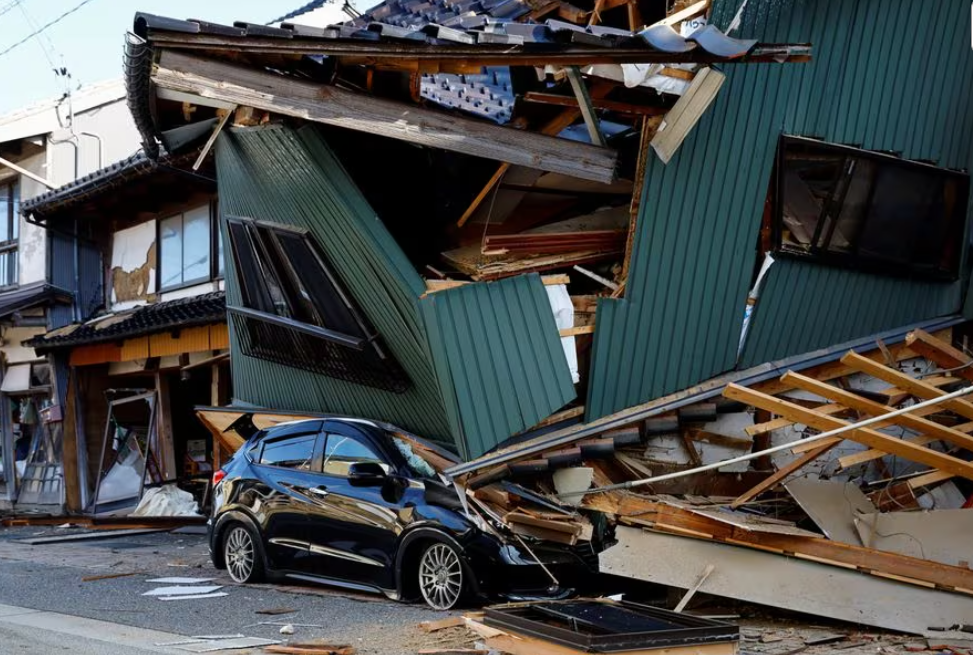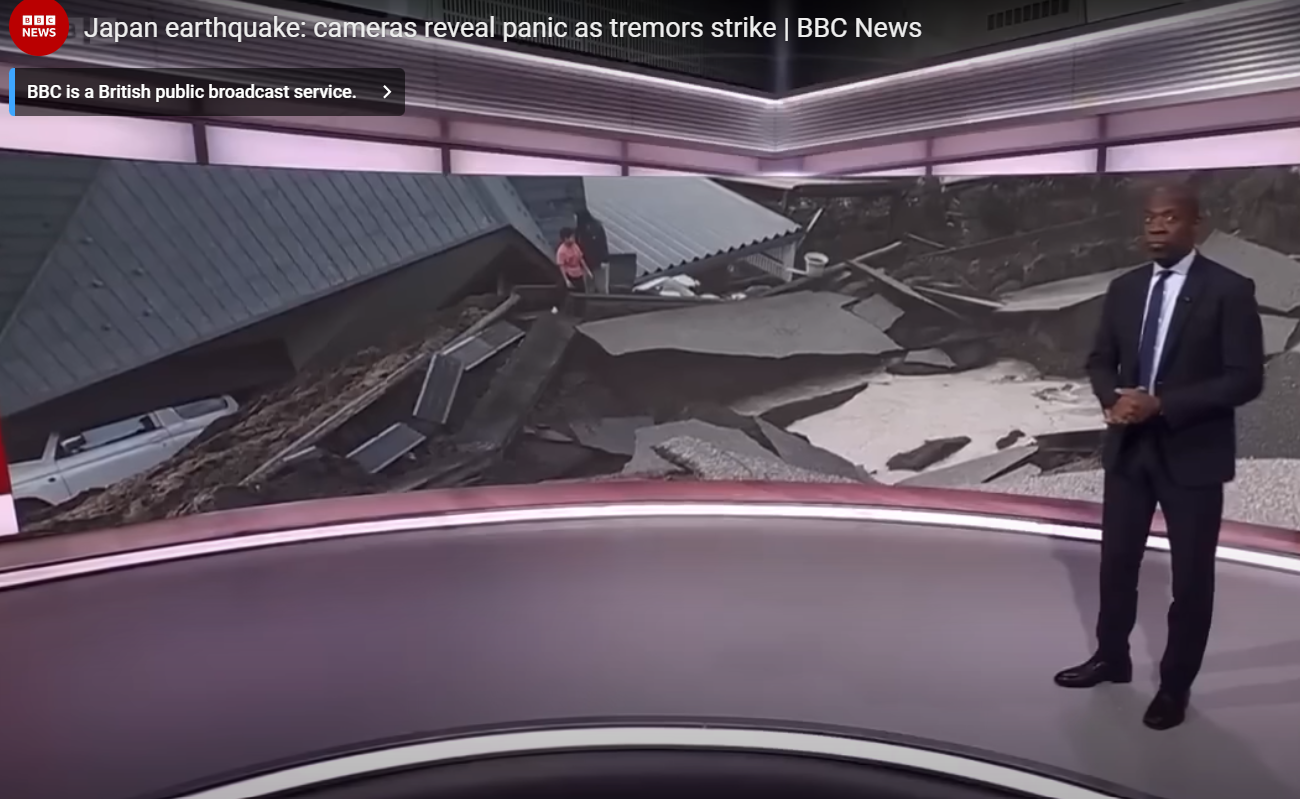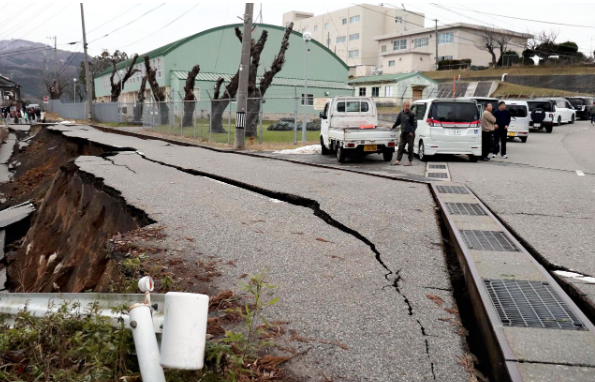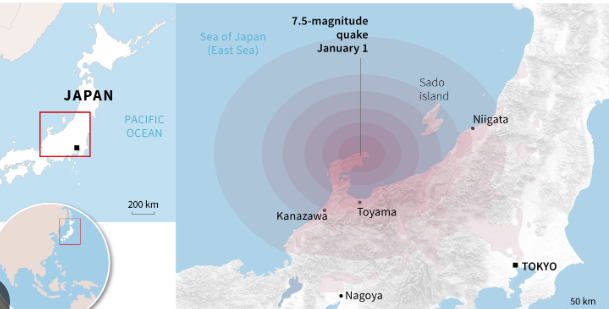
Japan earthquake and Tsunami Alert :12 dead as rescue operations continue,155 quakes in a day
Japan Earthquake Live Updates: Ishikawa faces another quake warning; 12 casualties reported as rescue operations persist
Japan Earthquake Latest: A significant seismic event in Japan resulted in a tsunami exceeding one meter in height, causing damage to homes and igniting a major fire. The country has experienced 155 earthquakes since Monday, including a powerful 7.6-magnitude tremor and another surpassing magnitude 6, according to the country’s meteorological office as reported by news agency AFP. The primary earthquake led to tsunami waves over a meter high, causing destruction to homes and setting off a major fire that continued overnight.
Local media broadcasts depicted scenes of collapsed buildings, sunken boats in a port, numerous charred homes, and residents enduring freezing overnight temperatures without power.

As of early Tuesday, at least six fatalities have been reported, with police and local authorities discovering bodies amid the rubble of collapsed structures, according to AFP.
Japan’s Meteorological Office informed the news agency that all tsunami warnings and advisories, instituted on Monday, have been lifted. Officials caution, however, that slight variations in tidal levels could still occur.
Prime Minister Fumio Kishida acknowledged the earthquakes’ toll, stating, “Very extensive damage has been confirmed, including numerous casualties, building collapses, and fires.” He emphasized the urgency of the ongoing rescue efforts, describing it as a “race against time.”
With the tsunami warning no longer in effect, Kishida announced plans to establish sea routes to reach isolated areas in the northern Noto peninsula. Approximately 100 members of the self-defense forces are currently engaged in search and rescue operations in the affected areas.
As of Tuesday, over 32,000 households in the region remain without power, according to AFP, citing the local energy provider. Major highways around the epicenter are closed, and bullet train services from Tokyo have been suspended.
In a statement, U.S. President Joe Biden expressed readiness to assist Japan, saying, “As close allies, the United States and Japan share a deep bond of friendship that unites our people. Our thoughts are with the Japanese people during this difficult time.”
Japan Earthquake and Tsunami Alert: Prime Minister Fumio Kishida emphasized the urgency of the search and rescue efforts, describing it as a race against time during an emergency disaster meeting.
Following a 7.6 magnitude earthquake, subsequent aftershocks, and a tsunami impacting Japan’s western coast, officials reported over a dozen casualties, with relief and rescue operations ongoing. An earthquake warning has been issued in Ishikawa prefecture.

Tsunami, a term meaning “harbor wave” in Japanese, results from seismic activity or volcanic eruptions beneath the ocean. When an earthquake occurs under the ocean, a sudden movement of the ocean floor displaces a significant volume of water, generating tsunami waves. A similar phenomenon can occur when a volcano erupts in the ocean, displacing water and creating large waves.
According to NASA, significant tsunamis typically originate in the deep ocean, gaining height as they approach shallower waters near the shore.
The death toll from yesterday’s earthquake has reached at least 12, with reports suggesting more casualties, particularly in the severely affected town of Wajima near the epicenter, where a massive blaze erupted on Monday. The national police agency confirmed six deaths, while the fire and disaster management agency reported 19 individuals in a state of cardiac arrest, according to Reuters. Search operations are ongoing, and the toll is expected to rise.
Rescue efforts intensified as emergency teams worked tirelessly to locate and aid those affected by the recent earthquake and tsunami in Japan. Prime Minister Fumio Kishida continued to emphasize the critical nature of the ongoing search and rescue operations, acknowledging the race against time to reach survivors.

The aftermath of the 7.6 magnitude earthquake and subsequent natural disasters has been devastating, with over a dozen reported casualties and the likelihood of an increasing toll as relief operations progress. A heightened earthquake warning in Ishikawa prefecture added to the challenges faced by both authorities and residents in the affected regions.
The term “tsunami,” derived from the Japanese word meaning “harbor wave,” underscores the colossal waves generated by seismic or volcanic activity beneath the ocean. The mechanics behind tsunamis involve the sudden displacement of a massive volume of water, either from an earthquake lifting or lowering the ocean floor or a volcanic eruption disrupting the ocean’s surface.
As search operations continued, it became apparent that the town of Wajima, near the epicenter, bore a significant brunt of the disaster. Reports from local media detailed a large-scale blaze that broke out on Monday, contributing to a substantial number of casualties. The national police agency confirmed six deaths, while the fire and disaster management agency indicated that 19 individuals were in a state of cardiac arrest, heightening concerns about the overall toll.
The situation remained fluid, with ongoing challenges such as the persistence of aftershocks, logistical difficulties in reaching isolated areas, and the significant number of households without power. International support was acknowledged, with U.S. President Joe Biden expressing readiness to provide assistance to Japan during this challenging period. The coming days would undoubtedly be crucial as the nation grappled with the aftermath and worked tirelessly to ensure the safety and well-being of its citizens.
For the latest updates-click here.

